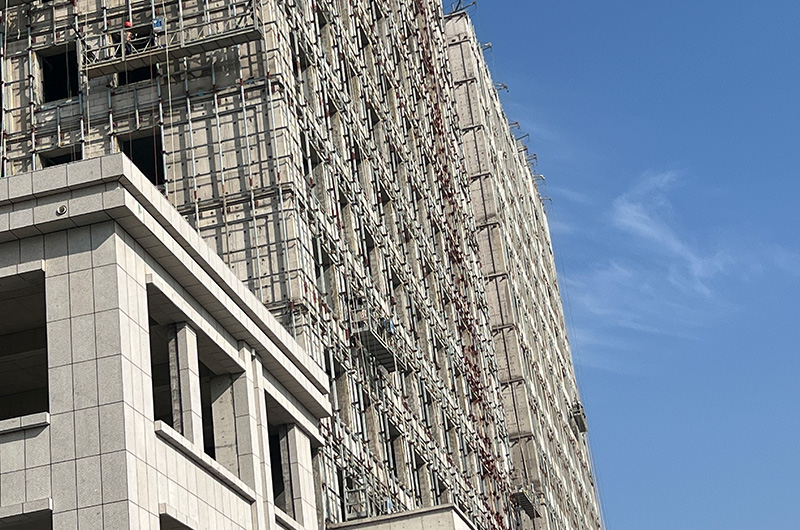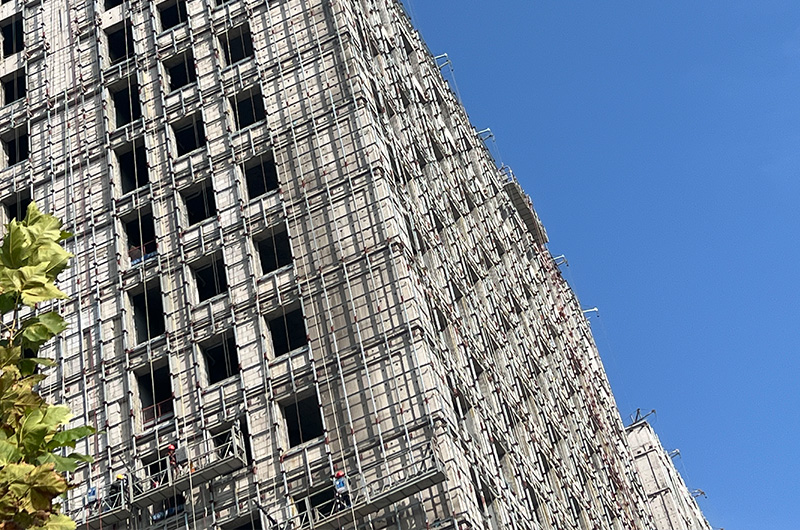Englist

Best suspended platform manufacturer in China, Skyliftec delivers unparalleled security.
Nov 05,2024
By:SKYLIFTEC
Maintenance and Inspection Best Practices for High Rise Suspended Scaffolding.When it comes to the maintenance and inspection of overhead scaffolds, best practices are essential to ensure their safety, stability and extended service life. Here are some best practice recommendations for overhead scaffolding maintenance and inspection:
1.Maintain best practices
Regular inspection and maintenance:
Develop a detailed maintenance and maintenance plan and follow it strictly. This includes regular checks for the structural integrity of the scaffolding, for loose or damaged connectors, and for the effectiveness of safety features.
Timely replacement of damaged parts:
Once any part of the scaffold (such as connectors, support rods, suspension devices, etc.) is found to be damaged or severely worn, it should be replaced immediately. Avoid using damaged or substandard parts to prevent safety incidents.
Keep clean and dry:
Clean the scaffolding regularly, especially to remove dust, dirt or other contaminants that may accumulate. Keep the scaffolding dry to prevent corrosion and rust.
Anti-corrosion treatment:
For scaffoldings exposed to harsh environments, appropriate anti-corrosion measures should be taken, such as coating anti-corrosion coatings or hot-dip galvanizing.
Avoid overloading:
Strictly observe the load limit of the scaffold and avoid placing heavy objects directly on the scaffold to prevent overloading resulting in structural damage.
2. Examine best practices
Professional inspectors:
Employ qualified and experienced inspectors to inspect the scaffolding regularly. They should have sufficient skills and knowledge to identify potential safety hazards.
Comprehensive inspection:
The inspection shall cover all parts and connection points of the scaffold, including suspension, support structure, safety net, guardrail, etc. Ensure that all components comply with safety standards.
Use professional tools:
During the inspection process, use the appropriate tools and equipment, such as measuring instruments, telescopes, non-destructive testing equipment, etc., to ensure the accuracy and reliability of the inspection.
Records and reports:
The results of each inspection are recorded in detail and the inspection report is prepared. The report should include information such as the date of the inspection, the inspectors, the problems found, and the corrective actions taken.
Timely repair and rectification:
Any problems found during the inspection should be repaired and rectified immediately. Ensure that scaffolding meets safety requirements after repair, and re-inspect and confirm.
3. Additional recommendations
Training and Education:
Conduct safety training and education for workers using scaffolding to improve their safety awareness and operational skills. Make sure they understand the proper use of scaffolding and the potential risks.
Emergency preparedness:
Develop emergency plans and measures to deal with possible scaffolding accidents. Ensure adequate emergency equipment and resources are available, and conduct regular emergency drills.
Regular evaluation and update:
As the construction project develops, the suitability of the scaffolding is regularly assessed. If necessary, the scaffolding is updated or upgraded to meet new safety requirements and construction needs.
By following these maintenance and inspection best practices, you can ensure the safety, stability, and service life of overhead scaffolds. At the same time, it also helps to improve construction efficiency and quality, and reduce the risk of safety accidents.

High Rise Suspended Scaffolding: A Cost-Effective Solution for Tall Buildings

Maintenance and Inspection Best Practices for High Rise Suspended Scaffolding

Environmental Considerations for Circular Suspended Scaffolding

Electric Suspended Platforms: The Future of High-Altitude Work

Modernizing Maintenance with Electric Suspended Platforms

SKYLIFTEC Engineering Materials Co., Ltd. is a source factory and exporter, is also the leading supplier of contruction gondola lift in China.
Tel:+86 15630730058
Email: info@skyliftec@.com
Fax:
Address:Cangzhou City, Hebei Province, China.